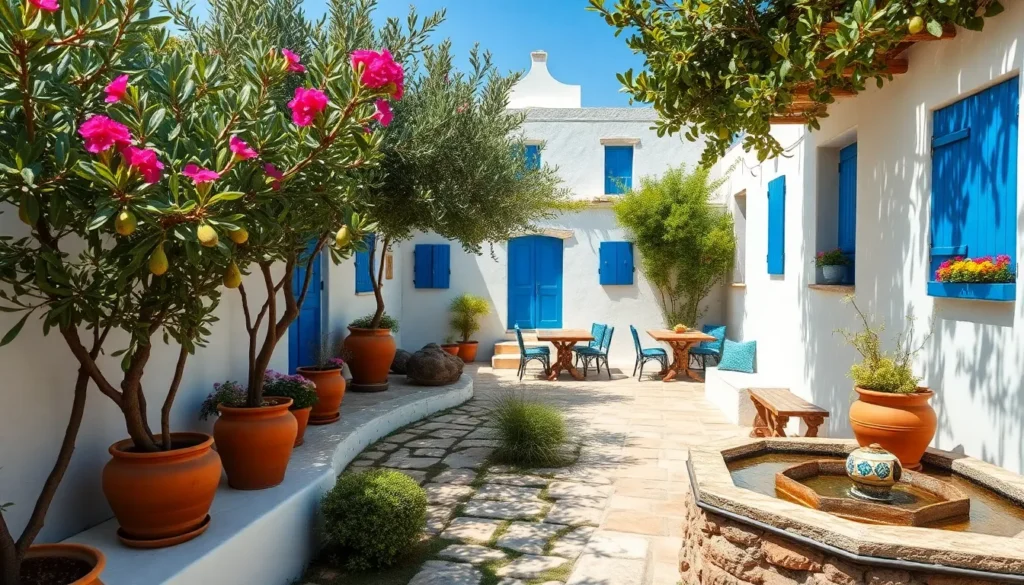Dreaming of transforming your outdoor space into a Mediterranean paradise? Greek garden design offers the perfect blend of rustic charm and timeless elegance that’ll transport you straight to the sun-soaked islands of Greece. We’re talking about creating an oasis where ancient wisdom meets modern landscaping – think whitewashed walls, aromatic herbs, and olive trees swaying in the breeze.
Greek gardens aren’t just about aesthetics; they’re about embracing a lifestyle that celebrates simplicity, natural beauty, and connection to the earth. We’ve discovered that these designs work beautifully in various climates and spaces, from sprawling backyards to cozy urban patios.
Whether you’re starting from scratch or looking to add Mediterranean flair to your existing garden, we’ll show you how to incorporate authentic Greek elements that create lasting impact. Get ready to discover design secrets that’ll make your neighbors wonder if you’ve secretly relocated to Santorini.
Create a Mediterranean Color Palette With White and Blue Accents
Greek gardens rely on a timeless color scheme that instantly transports you to the sun-drenched islands of the Aegean Sea. We’ll show you how to master this classic palette that forms the foundation of authentic Mediterranean design.
Incorporate Whitewashed Walls and Structures
Whitewashed surfaces create the iconic backdrop that defines Greek garden aesthetics. Paint your garden walls, pergolas, and outdoor structures with bright white paint to reflect sunlight and create visual coolness during hot summer months.
Choose lime-based whitewash for authentic texture and natural antibacterial properties that traditional Greek builders have used for centuries. Apply this coating to stone retaining walls, garden sheds, or fence panels to establish your Mediterranean foundation.
Transform existing brick or concrete structures by adding a fresh coat of white stucco finish. This technique works particularly well on garden borders, raised planters, and outdoor seating areas where you want to create focal points.
Add Cobalt Blue Ceramic Pots and Planters
Cobalt blue containers provide the perfect contrast against white backgrounds while housing your Mediterranean plants. Select large ceramic urns in deep blue glazes to display olive trees, lavender, or rosemary as statement pieces throughout your garden.
Place smaller blue pots along pathways filled with herbs like oregano, thyme, and basil to create aromatic walking experiences. These containers should vary in height from 8 to 24 inches to establish visual rhythm and prevent monotonous arrangements.
Arrange blue planters in odd-numbered groupings of three or five to follow natural design principles. Position the largest vessel as your anchor piece, then surround it with smaller companions to create balanced compositions.
Use Natural Stone in Warm Beige and Gray Tones
Natural stone pathways in warm beige and soft gray shades complete your Mediterranean color story. Install limestone pavers or travertine tiles to create elegant walkways that complement both white walls and blue accents.
Choose flagstone in honey beige tones for patio areas where you’ll place outdoor dining furniture. This material ages beautifully and develops character over time, matching the weathered charm of authentic Greek landscapes.
Granite or slate steps in muted gray colors provide subtle transitions between garden levels. These neutral stones serve as perfect backdrops that allow your colorful plantings and blue pottery to take center stage without competing for attention.
Design Terraced Garden Levels for Authentic Greek Landscapes
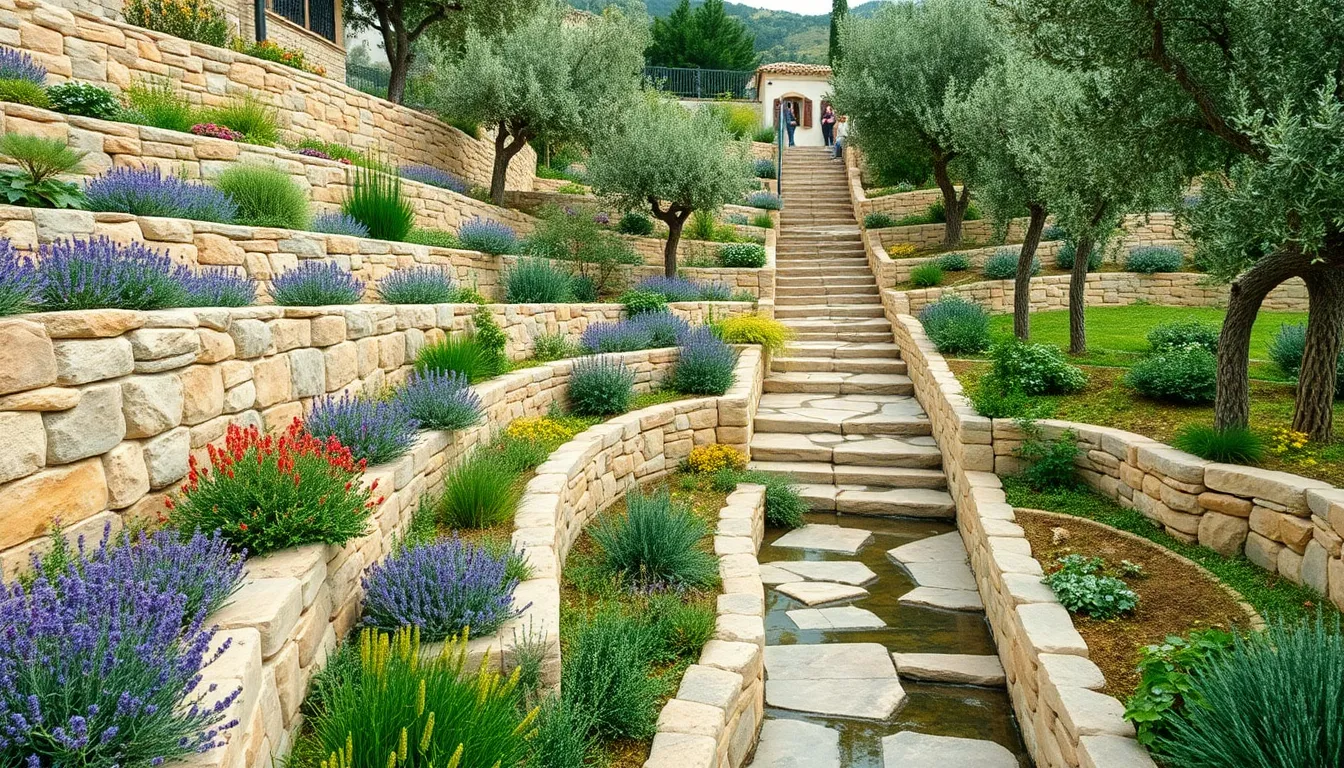
Authentic Greek landscapes showcase the artistry of working with natural slopes and elevations to create breathtaking multi level garden designs. We’ll transform challenging hillside terrain into stunning terraced gardens that capture the timeless beauty of Mediterranean landscapes.
Build Stone Retaining Walls for Multi-Level Planting
Stone retaining walls form the structural backbone of authentic Greek terraced gardens, providing essential support while creating distinct planting zones. We recommend using local limestone or fieldstone to construct walls that blend seamlessly with the natural industry. These walls should range from 2 to 4 feet in height to maximize planting space while maintaining visual balance across the garden levels.
Natural materials like weathered stone create the most authentic appearance and offer superior durability against Mediterranean weather conditions. We suggest incorporating decorative elements such as carved stone details or embedded pottery fragments to enhance the walls’ aesthetic appeal. Proper construction techniques ensure these walls provide long term structural support for soil retention and plant root systems.
Varying wall heights throughout the garden creates ever-changing visual interest while accommodating different plant requirements. We often design taller walls for areas needing deeper soil depth and shorter walls for shallow rooted Mediterranean plants like lavender and thyme.
Create Stepped Pathways Between Garden Sections
Stepped pathways connect terraced levels while maintaining the rustic charm essential to Greek garden design. We construct these pathways using the same stone materials as retaining walls to create visual continuity throughout the industry. Natural stone steps should measure 6 to 8 inches in height with treads spanning 12 to 15 inches for comfortable navigation.
Pathways meander gently between garden levels rather than following rigid straight lines, mimicking the organic flow of traditional Greek hillside villages. We line these walkways with aromatic herbs like rosemary and oregano to release pleasant fragrances as visitors brush against the plantings. Strategic placement of olive trees and grapevines along pathway edges provides natural shade and authentic Mediterranean atmosphere.
Stone placement allows for gaps between pavers where ground covering plants can establish, softening the pathway’s appearance over time. We recommend using moss or creeping thyme in these spaces to create a weathered, time worn aesthetic that’s characteristic of ancient Greek gardens.
Install Proper Drainage Systems for Hillside Gardens
Effective drainage systems prevent soil erosion and protect plant health in terraced Greek gardens built on sloping terrain. We install French drains behind retaining walls to redirect excess water away from structural foundations and planted areas. These drainage channels should extend the full length of each terrace level with gravel bedding that promotes rapid water movement.
Surface drainage requires careful grading to direct rainwater toward designated collection points rather than allowing uncontrolled runoff. We create subtle slopes of 2 to 3 percent across each terrace to guide water flow without creating standing puddles that damage plant roots. Strategic placement of drainage outlets prevents water from undermining retaining wall stability.
Water collection systems can incorporate traditional Greek elements like stone channels and small pools that serve both functional and decorative purposes. We often design these features to feed into herb gardens or olive groves where controlled irrigation supports plant growth during dry Mediterranean summers.
Permeable materials in pathway construction allow rainwater to infiltrate naturally rather than creating additional surface runoff challenges. We use crushed stone or gravel bases beneath stone pavers to promote drainage while maintaining pathway stability throughout seasonal weather changes.
Plant Traditional Greek Herbs and Vegetables
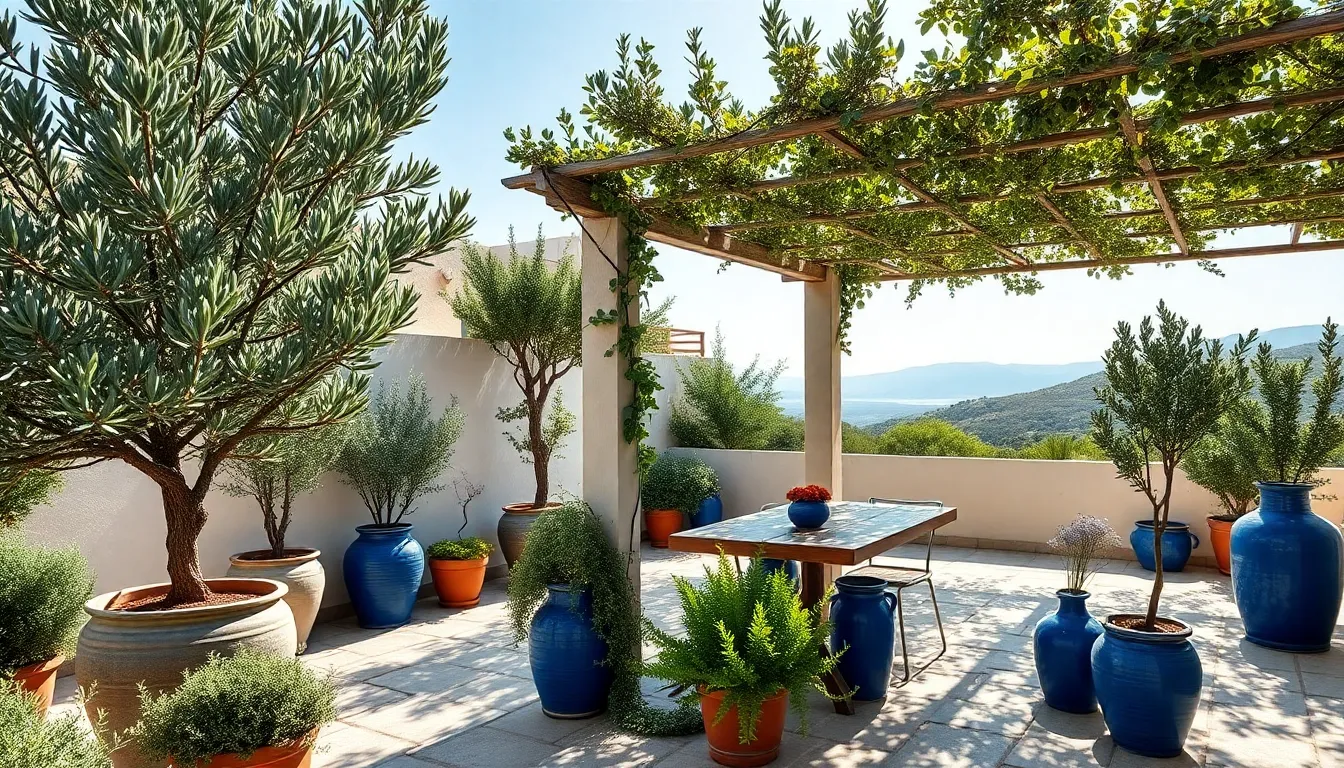
Building on our Mediterranean foundation, we’ll now incorporate the living essence of Greek gardens through authentic plantings that bring both beauty and functionality to your outdoor space.
Grow Aromatic Mediterranean Herbs Like Oregano and Thyme
Oregano and thyme form the aromatic backbone of any authentic Greek garden. These drought-tolerant herbs thrive in sunny, well-drained conditions and release their distinctive fragrances when brushed against or warmed by the sun. We recommend planting oregano in raised beds or containers where its spreading habit can be controlled, while thyme works beautifully as a border plant along stone pathways.
Kitchen gardens in ancient Greek and Roman styles often flanked courtyards with these essential herbs, creating both practical cooking ingredients and sensory garden experiences. Plant them in clusters rather than single specimens to maximize their visual and aromatic impact. Both herbs require minimal water once established, making them perfect companions for your Mediterranean color palette of whites and blues.
Cultivate Olive Trees as Focal Points
Olive trees serve as the crown jewels of Greek garden design, symbolizing peace and endurance while providing timeless Mediterranean character. Their silvery leaves catch sunlight beautifully and create stunning contrasts against white walls and cobalt blue pottery. We suggest positioning olive trees as structural anchor points in your terraced garden levels, where their gnarled trunks can be appreciated from multiple viewing angles.
Surrounding olive trees with gravel pathways or stone mulch mimics traditional Greek courtyards and helps with drainage. These iconic trees work particularly well in larger containers if you’re gardening in colder climates, allowing you to move them to protected areas during winter months. Their naturally sculptural form eliminates the need for extensive pruning while maintaining that authentic Mediterranean aesthetic.
Add Grapevines for Natural Shade and Privacy
Grapevines transform functional garden structures into lush, productive canopies that embody the Greek outdoor lifestyle. Train them over pergolas, arbors, or along fence lines to create natural cooling zones perfect for al fresco dining areas. We’ve found that grapevines establish quickly and provide both privacy screening and delicious fruit within a few growing seasons.
Ancient Greek villas featured vine-covered spaces where guests enjoyed shaded outdoor gatherings, and you can recreate this atmosphere in your own garden. Choose varieties suited to your climate zone, and provide sturdy support structures since mature vines become quite heavy. The dappled shade they create protects more delicate plants below while maintaining that characteristic Mediterranean garden layering effect.
Install Classic Greek Architectural Elements
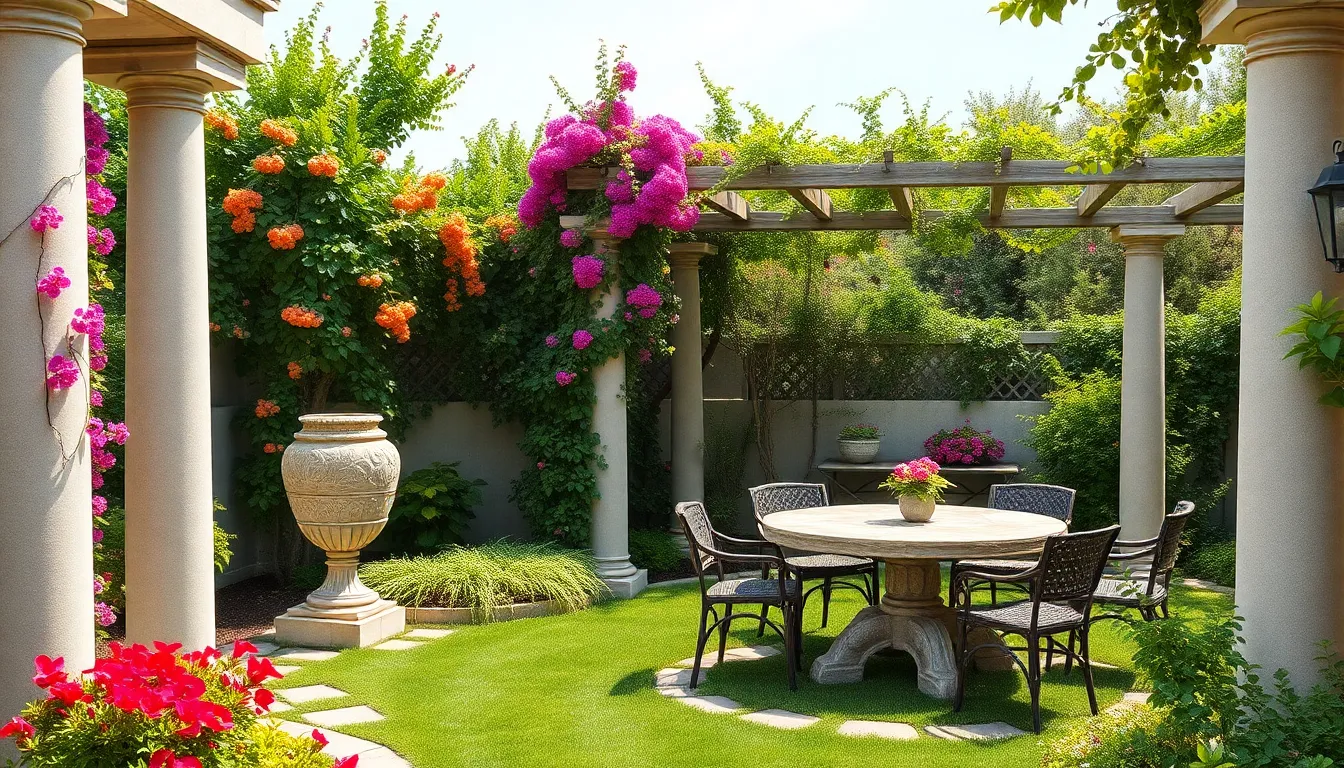
Elevating our Mediterranean garden design requires incorporating timeless architectural features that define authentic Greek outdoor spaces. These structural elements transform ordinary gardens into sophisticated retreats that capture the essence of ancient Greek beauty.
Add Pergolas and Arbors for Climbing Plants
Building pergolas and arbors creates the perfect framework for supporting climbing plants like grapevines or flowering vines in our Greek-inspired gardens. These wooden or stone structures add both beauty and functionality while providing natural shade for relaxation areas. We can position pergolas over walkways to create dramatic entrances or place them above seating areas for intimate dining spaces.
Climbing plants flourish on these supports, transforming simple structures into lush green canopies that mirror traditional Greek courtyards. Grapevines work particularly well, offering seasonal interest with their changing foliage and potential fruit harvest. Flowering vines like bougainvillea or jasmine add vibrant colors and intoxicating fragrances that enhance the sensory experience of our outdoor sanctuary.
Incorporate Columns and Classical Urns
Installing columns along garden walkways or perimeters instantly elevates the visual appeal while providing essential structural elements that define Greek architecture. We can use these columns to frame garden views, support climbing plants, or simply serve as standalone decorative features that anchor our industry design. Classical urns complement columns perfectly, creating harmonious compositions that balance elegance with functionality.
Large ceramic urns serve dual purposes as both decorative elements and practical planters for flowers or aromatic herbs like rosemary and thyme. We should position these urns at varying heights and group them in odd numbers to create ever-changing visual interest throughout our garden spaces. Combining columns with strategically placed urns establishes focal points that guide visitors through our Mediterranean oasis.
Create Outdoor Dining Areas With Stone Tables
Designing outdoor dining spaces with stone tables captures the communal spirit of traditional Greek courtyards where families gathered for meals and conversation. We can place these durable stone surfaces under pergolas or in naturally shaded areas to create comfortable gathering spots that withstand weather changes. Natural stone materials like limestone or marble echo the authentic textures found in Greek architecture.
Stone tables provide permanent outdoor dining answers that require minimal maintenance while offering timeless appeal. We should surround these tables with comfortable seating options like stone benches or wrought iron chairs that complement our garden’s overall aesthetic. This setup transforms our garden into an extension of our living space, perfect for hosting intimate dinners or casual gatherings under the Mediterranean sun.
Use Natural Stone and Gravel for Authentic Pathways
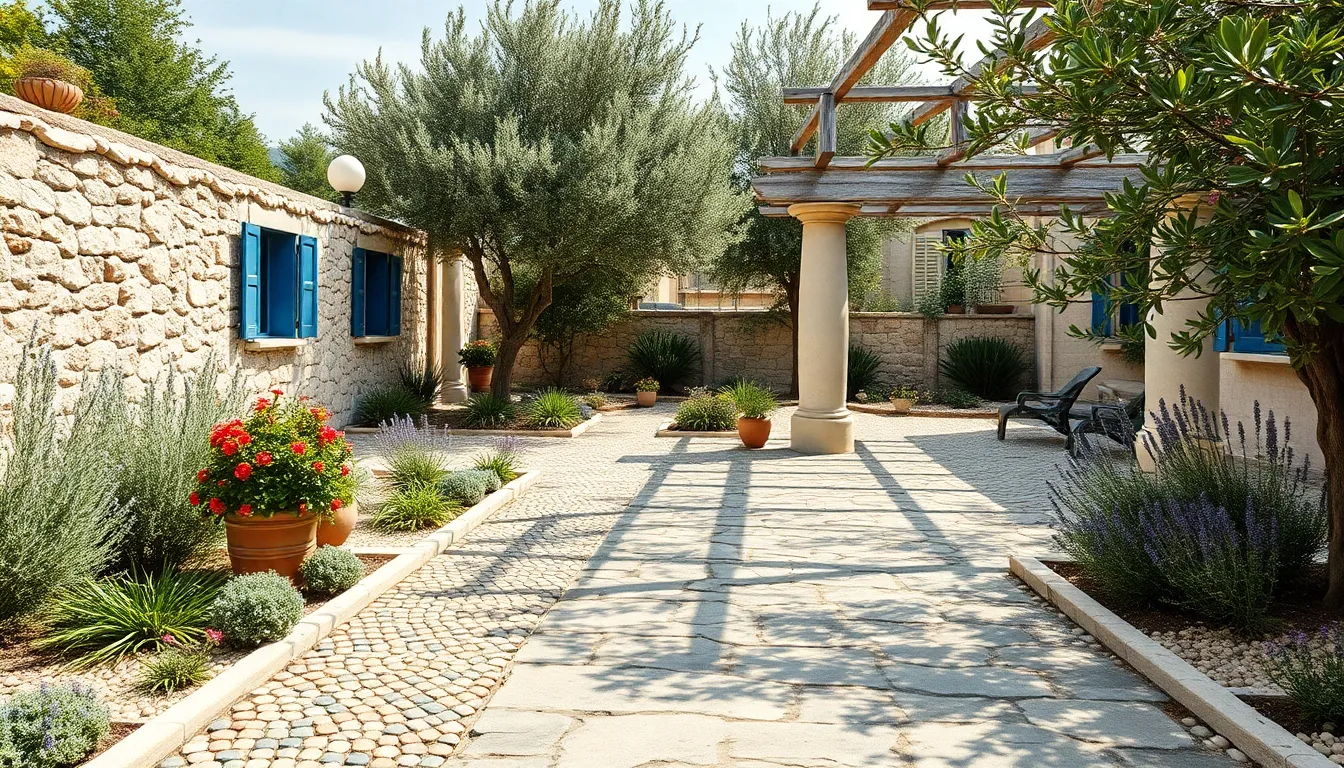
Authentic Greek garden pathways begin with limestone and marble materials that evoke centuries of Mediterranean history. We recommend incorporating natural stone elements that create timeless connections between different garden areas while maintaining the rustic elegance that defines traditional Greek landscapes.
Design Mosaic Pebble Walkways
Mosaic pebble walkways showcase classic Greek design elements through vibrant color patterns and intricate textures. We suggest creating these pathways using smooth river stones in contrasting hues like white marble chips combined with dark volcanic pebbles. Traditional Greek patterns include geometric spirals, wave motifs, and floral designs that guide visitors through your garden spaces.
Each walkway section should measure approximately 3-4 feet wide to accommodate comfortable passage while showcasing the detailed mosaic work. We recommend embedding pebbles in a sand and cement base to ensure durability against weather conditions. Natural drainage occurs between the stones, preventing water accumulation during rainy seasons.
Install Flagstone Patios and Seating Areas
Flagstone patios provide weathered natural surfaces that complement Greek garden aesthetics perfectly. We choose flagstone materials in warm beige and gray tones that harmonize with existing stone retaining walls and terraced garden features. These surfaces create inviting spaces beneath olive trees and pergolas where families gather for outdoor dining.
Installation requires level ground preparation with proper drainage systems to prevent shifting over time. We suggest varying flagstone sizes from 12-inch squares to irregular shapes that create organic patterns reminiscent of ancient Greek courtyards. Gaps between stones can accommodate low growing herbs like thyme and oregano that release fragrance when stepped upon.
Create Decorative Rock Gardens With Native Plants
Decorative rock gardens combine natural limestone and marble elements with authentic Greek vegetation for stunning visual arrangements. We incorporate native plants including olive trees, lavender, and rosemary that thrive in Mediterranean climates while requiring minimal maintenance. These combinations create textural contrasts between smooth stone surfaces and aromatic plant foliage.
Strategic rock placement provides natural drainage around plant root systems while creating microclimates for different species. We recommend grouping plants in odd numbers with varying heights to achieve balanced compositions. Gravel mulch around plants adds texture and prevents soil erosion while maintaining the authentic Greek garden appearance throughout seasonal changes.
Incorporate Water Features Inspired by Greek Islands
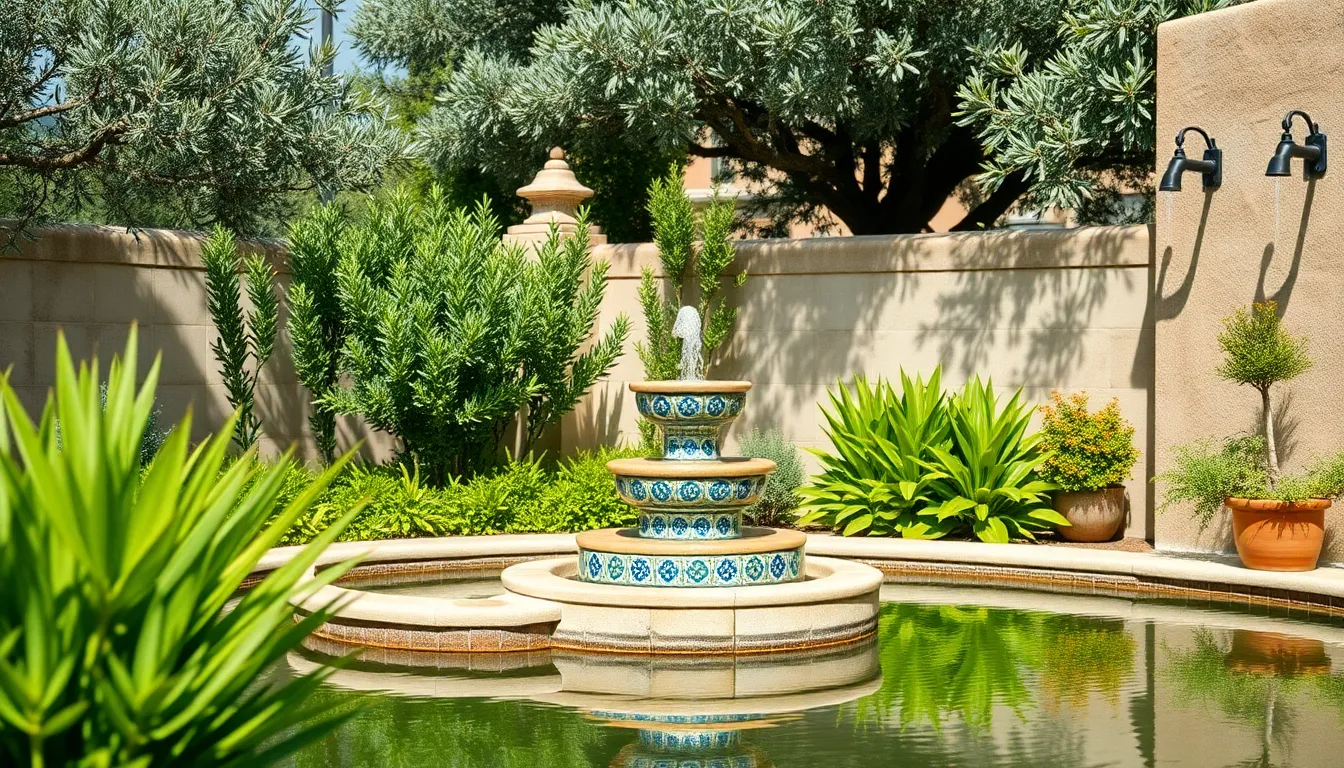
Water elements bring the soothing essence of the Aegean Sea directly into our Mediterranean garden spaces. These features transform ordinary outdoor areas into tranquil retreats that capture the authentic spirit of Greek island living.
Build Small Fountains With Ceramic Tile Details
Ceramic column fountains create stunning focal points that embody traditional Greek architectural beauty. We recommend selecting fountains with ridged details and colorful glazed accents that reflect the vibrant Mediterranean aesthetic. Blue ceramic tiles work particularly well as they evoke the deep colors of the Mediterranean Sea while adding sophisticated visual interest to fountain designs.
Tiered fountain structures offer multiple levels of cascading water that generate gentle, relaxing sounds throughout our garden space. Stone and concrete materials provide durability while maintaining the authentic Greek appearance we desire. Glazed ceramic accents in blues and whites can be strategically placed to create intricate patterns that mirror traditional Greek pottery designs.
Traditional amphora vessels serve as unique fountain features that blend historical authenticity with modern functionality. These Greek inspired water vessels create gentle flows while adding sculptural elements to our outdoor spaces. Positioning multiple urns at varying heights creates ever-changing visual layers that enhance the overall Mediterranean garden design.
Add Reflecting Pools for Tranquil Ambiance
Reflecting pools mirror surrounding garden elements like olive trees, columns, and flowering plants to create depth and visual expansion in our outdoor spaces. These serene water features enhance the sense of tranquility that characterizes authentic Greek island environments. Even subtle water movement from gentle breezes creates soothing ripples that add life to the reflective surface.
Strategic placement near seating areas or dining spaces allows us to enjoy the calming effects of still water while entertaining guests or relaxing outdoors. Small reflecting pools work well in compact gardens while larger installations can serve as dramatic centerpieces in expansive Mediterranean landscapes. Natural stone edging using limestone or marble complements the pool’s reflective qualities while maintaining design consistency.
Minimal maintenance requirements make reflecting pools practical additions to busy lifestyles while delivering maximum visual impact. Clear water creates perfect reflections of blue skies and white architectural elements that define Greek garden aesthetics. These features work especially well when integrated with surrounding stone pathways and herb plantings.
Install Wall-Mounted Water Spouts
Wall mounted fountains maximize water feature benefits without consuming valuable ground space in smaller garden areas. These compact installations create flowing water effects against neutral colored backdrops that are typical of traditional Greek architecture. Stone or ceramic spouts can be integrated directly into existing walls or specially constructed feature walls.
Flowing water effects from wall spouts generate continuous soothing sounds that mask urban noise while creating peaceful garden atmospheres. We can position these features near seating areas or along pathways to enhance the sensory experience of moving through our Mediterranean garden spaces. Multiple spouts at different heights create layered water sounds that mimic natural Greek island water features.
Space efficient designs allow us to incorporate water elements even in narrow garden areas or courtyards where traditional fountains might overwhelm the space. Ceramic tile surrounds in blue and white patterns can frame these installations to reinforce the Greek island aesthetic. Simple basin collections at the base prevent water waste while supporting nearby herb plantings that thrive with additional moisture.
Choose Drought-Resistant Plants for Low-Maintenance Beauty
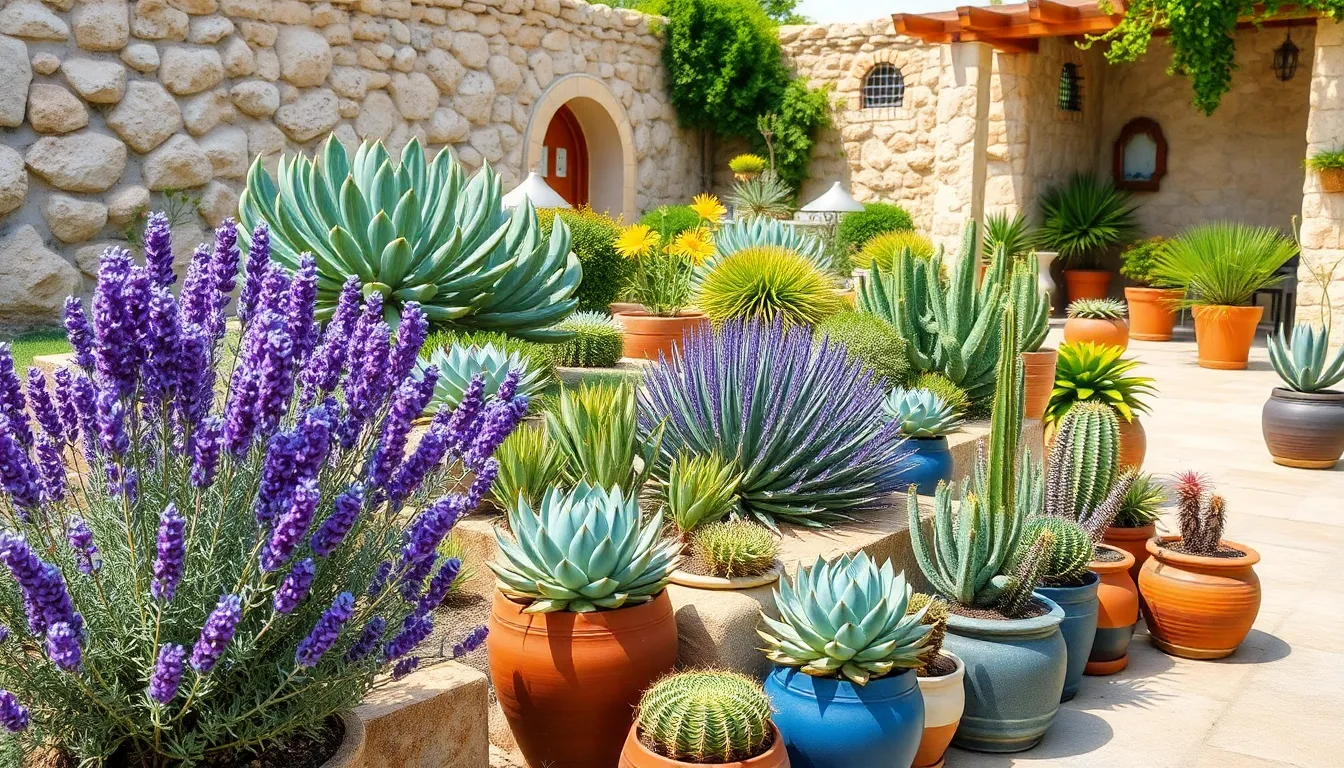
Greek gardens thrive when we select plants that naturally withstand hot, dry summers and mild winters. Our plant choices become the foundation for creating sustainable beauty that requires minimal water while delivering maximum visual impact.
Select Native Mediterranean Flowers and Shrubs
Mediterranean plants offer the perfect combination of resilience and authentic Greek charm for our gardens. We should focus on flowering shrubs like oleander and bougainvillea, which produce vibrant blooms while tolerating drought conditions throughout the growing season.
Aromatic herbs such as thyme and sage create natural groundcover that releases fragrance when we brush against their leaves. These native plants support local ecology while replicating the timeless rustic appeal we see in traditional Greek landscapes.
Stone walls and patios provide the ideal backdrop for these Mediterranean species. Our native plant selections blend seamlessly with existing hardscape elements, creating cohesive outdoor spaces that feel authentically Greek.
Plant Lavender and Rosemary for Fragrance
Lavender transforms any garden space with its distinctive purple spikes and intoxicating scent that attracts beneficial pollinators. We can plant lavender in clusters along pathways or near seating areas where its fragrance enhances our outdoor experience.
Rosemary provides year-round evergreen structure with needle-like foliage that releases aromatic oils when touched. This versatile herb works beautifully as a low hedge or focal point plant, offering both ornamental value and culinary benefits for our Mediterranean cooking.
Both plants thrive in well-drained soil and full sun conditions typical of Greek climates. Our investment in these classic herbs pays dividends through their drought tolerance, minimal maintenance requirements, and dual-purpose nature as both decorative and functional garden elements.
Use Succulents and Cacti for Modern Greek Style
Succulents add contemporary flair to traditional Greek gardens through their sculptural forms and striking architectural qualities. We can arrange different varieties in ceramic pots or plant them directly in garden beds to create textural contrast against classic Mediterranean elements.
Cacti bring modern minimalism to our outdoor spaces while requiring virtually no water once established. Their unique shapes and occasional colorful blooms provide visual interest that complements whitewashed walls and neutral stone surfaces.
Contemporary Greek garden design benefits from mixing traditional and modern elements for timeless appeal. Our succulent selections create dramatic focal points that work especially well in container arrangements or as accent plants among more conventional Mediterranean species.
Create Outdoor Living Spaces for Al Fresco Dining
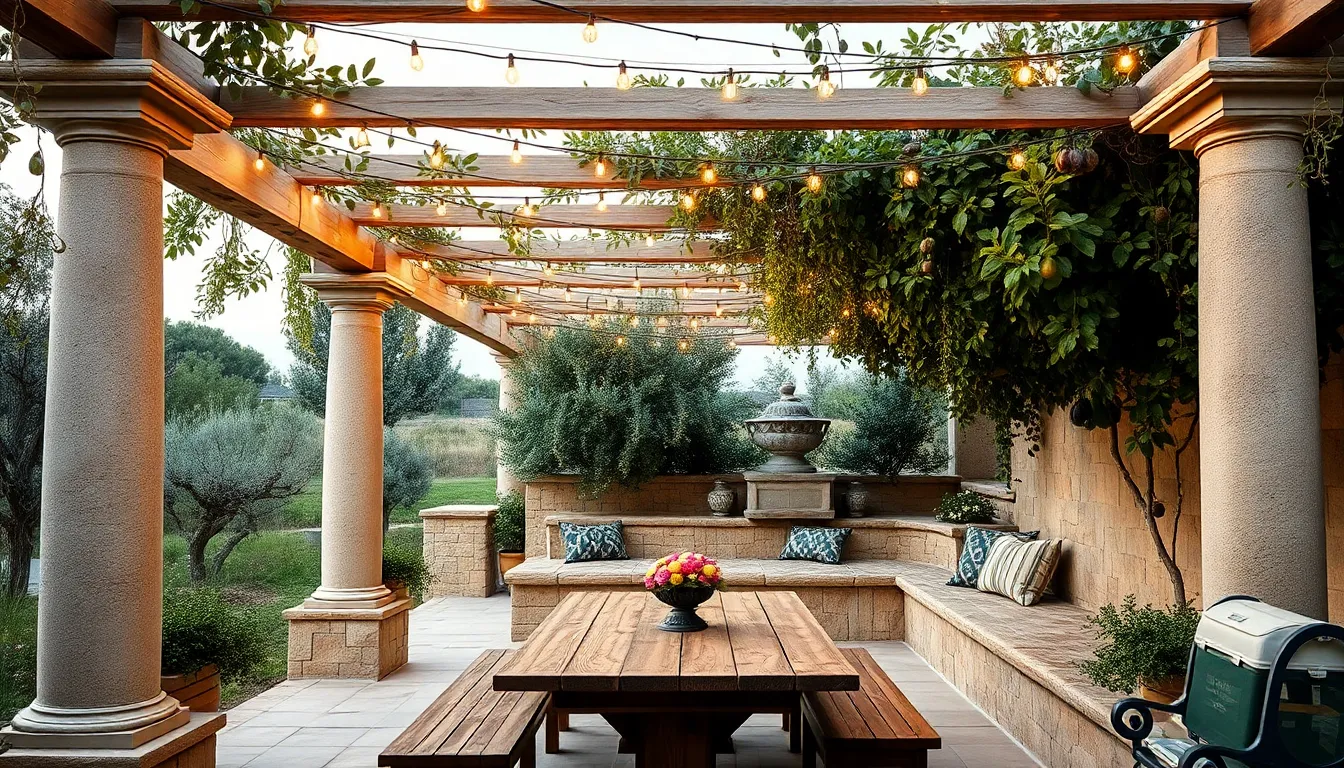
Building on our Mediterranean foundation of stone pathways and water features, we’ll now transform your garden into a complete outdoor sanctuary perfect for entertaining and relaxation. Central courtyards anchor Greek garden design by providing open, paved areas enclosed by low walls or columns that evoke privacy and structure, making them ideal for hosting meals and socializing.
Design Shaded Seating Areas With Natural Materials
Pergolas draped with climbing vines create the perfect Mediterranean retreat. We recommend installing wood or stone pergolas that support grape or wisteria vines, providing natural shade while maintaining authentic Greek aesthetics. These structures transform harsh sunlight into gentle, dappled patterns that make outdoor dining comfortable throughout the day.
Columns inspired by Greek architecture elevate your seating arrangements. Stone or stucco columns can support shade structures while adding classical elegance to your outdoor space. Built-in benches made from natural stone or weathered wood blend seamlessly into the garden’s harmony, creating permanent seating that requires minimal maintenance.
Strategic tree placement delivers both beauty and function. Olive and fig trees offer essential dappled shade while contributing to your garden’s Mediterranean character. Position these shade trees near seating areas to create natural canopies that protect guests from intense sun while adding visual interest through their distinctive silhouettes.
Install Outdoor Kitchens and Grilling Stations
Stone cooking stations embody traditional Greek outdoor dining culture. We suggest building outdoor kitchens using natural stone or stucco materials that mirror your garden’s existing palette. These durable surfaces withstand weather while maintaining the authentic Mediterranean style that defines Greek garden design.
Wood fired ovens connect your space to ancient cooking traditions. Installing traditional ovens or specialized grills allows you to recreate authentic Greek flavors in your own backyard. These cooking elements become focal points for outdoor entertaining, encouraging the communal dining experience that’s central to Mediterranean lifestyle.
Practical counter space and storage complete your outdoor kitchen. Include built-in storage answers and adequate prep surfaces to make alfresco cooking effortless. Weather resistant cabinets and stone countertops ensure your outdoor kitchen remains functional year-round, supporting seamless garden courtyard entertaining.
Add String Lights for Evening Ambiance
Warm string lights transform your garden into an enchanting evening retreat. Hang lights across pergolas, between trees, or along garden walls to create soft, inviting illumination that extends your outdoor living hours. This gentle lighting mimics the romantic atmosphere of traditional Greek tavernas and coastal villages.
Candle lanterns and torches add flickering Mediterranean charm. Position these elements strategically throughout your seating areas to create intimate pockets of light. The dancing flames evoke the authentic feeling of Greek nights while providing practical illumination for evening dining and conversation.
Accent lighting highlights your garden’s architectural features. Illuminate columns, fountains, or stone pathways to emphasize the classical elements that define your Greek inspired space. This strategic lighting approach creates depth and visual interest while ensuring safe navigation through your outdoor living areas after dark.
Conclusion
Creating your own Greek garden sanctuary doesn’t require a Mediterranean climate or endless resources. We’ve shown you how strategic plant choices drought-resistant varieties and authentic materials can transform any outdoor space into a slice of the Aegean.
The beauty of Greek garden design lies in its timeless simplicity. Whether you’re adding a single olive tree or designing an entire terraced industry these elements work together to create spaces that invite relaxation and celebration.
Your journey toward Mediterranean-inspired outdoor living starts with choosing the elements that speak to you most. Begin small experiment with aromatic herbs or install a simple water feature and watch as your garden evolves into the peaceful retreat you’ve always envisioned.
Frequently Asked Questions
What is Greek garden design and what makes it unique?
Greek garden design combines rustic charm with elegant simplicity, reflecting the natural beauty of Mediterranean landscapes. It features whitewashed walls, cobalt blue accents, stone pathways, terraced levels, and aromatic herbs. This style creates an authentic Greek atmosphere that evokes the essence of the Aegean islands while being adaptable to various climates and spaces.
What colors should I use for an authentic Mediterranean garden palette?
The classic Mediterranean color palette centers on white and blue accents. Use whitewashed walls and structures as your backdrop, preferably with lime-based whitewash for authentic texture. Add cobalt blue ceramic pots and planters for striking contrast, and incorporate warm beige and gray natural stone tones for pathways and structural elements.
How do I create terraced gardens like those in Greece?
Build stone retaining walls using local limestone or fieldstone to create distinct planting zones at varying heights. Connect levels with stepped pathways made from matching stone materials. Install proper drainage systems including French drains and subtle slopes to prevent erosion while maintaining the rustic charm of authentic Greek landscapes.
Which plants are essential for a Greek garden design?
Focus on aromatic Mediterranean herbs like oregano, thyme, sage, and rosemary planted in sunny, well-drained areas. Include olive trees as focal points and structural anchors. Add grapevines for natural shade and privacy. Choose drought-resistant plants like oleander, bougainvillea, and lavender that thrive in hot, dry conditions while providing vibrant colors.
What architectural elements should I include in my Greek garden?
Incorporate pergolas and arbors to support climbing vines and create shaded areas. Add classical columns and decorative urns to frame views and serve as focal points. Install stone dining tables surrounded by comfortable seating to echo traditional Greek courtyards. These elements transform your garden into an authentic extension of Greek outdoor living.
How can I create authentic Greek-style pathways?
Use natural materials like limestone, travertine, or marble for walkways that reflect Mediterranean history. Design mosaic pebble pathways with contrasting colors and traditional Greek patterns. Install flagstone patios with proper drainage, and incorporate low-growing herbs between stones. Choose permeable materials to promote natural water flow and prevent erosion.
What water features work best in Greek garden design?
Build small fountains with ceramic tile details and tiered structures for gentle water sounds. Create reflecting pools to add tranquil ambiance and visual depth. Install wall-mounted water spouts as space-efficient options that provide flowing water effects. These features enhance the sensory experience while maintaining authentic Greek architectural styling.
How do I design outdoor dining spaces in Greek garden style?
Create central courtyards with open, paved areas for socializing and meals. Design shaded seating areas using pergolas with climbing vines. Install outdoor kitchens with natural stone or stucco materials. Add warm string lights, candle lanterns, and accent lighting for evening ambiance reminiscent of traditional Greek tavernas.

